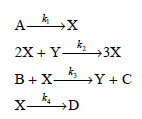Cubic autocatalytic steps are important in a reaction mechanism referred to as the brusselator (named in honor
Question:
Cubic autocatalytic steps are important in a reaction mechanism referred to as the “brusselator†(named in honor of the research group in Brussels that initially discovered this mechanism):

If [A] and [B] are held constant, this mechanism demonstrates interesting oscillatory behavior that we will explore in this problem.
a. Identify the autocatalytic species in this mechanism.
b. Write down the differential rate expressions for [X] and[Y].
c. Using these differential rate expressions, employ Euler’s method (Section 35.6) to calculate [X] and [Y] versus time under the conditions k1 = 1.2 s-1, k2 = 0.5 M-2 s-1, k3 = 3 M-1 s-1, k4 = 1.2 s-1, and [A]0 = [B]0 = 1M. Begin with [X]0 = 0.5M [X]0 = 0.5M and [Y]0 = 0.1M. A plot of [Y] versus [X] should look like the top panel in the figure in the text.
d. Perform a second calculation identical to that in part (c), but with [X]0 = 3.0M and [Y]0 = 3.0M. A plot of [Y] versus [X] should look like the bottom panel.
e. Compare top and bottom panels. Notice that the starting conditions for the reaction are different (indicated by the black spot). What do the figures indicate regarding the oscillatory state the system evolves to?
Step by Step Answer:






